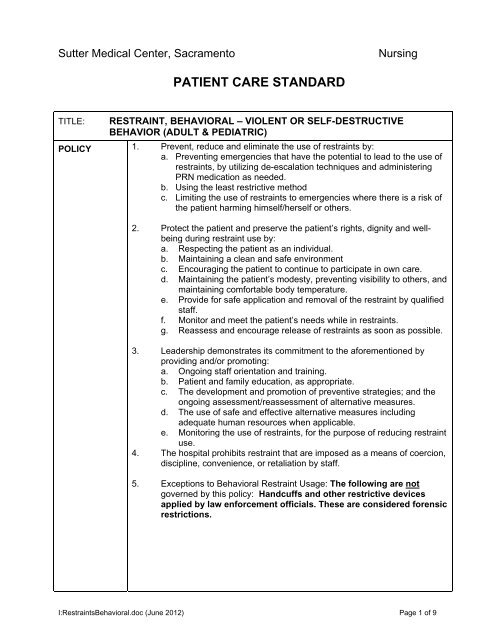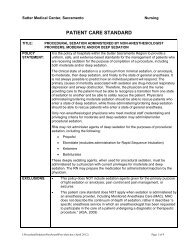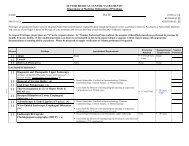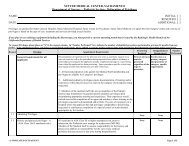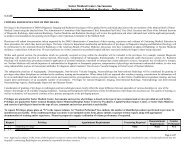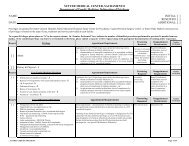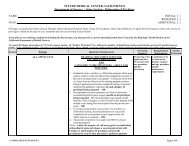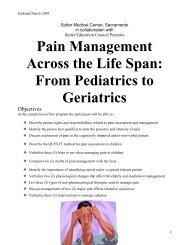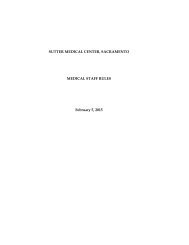Policy on Behavioral Seclusion and Restraint - Sutter Medical Center
Policy on Behavioral Seclusion and Restraint - Sutter Medical Center
Policy on Behavioral Seclusion and Restraint - Sutter Medical Center
You also want an ePaper? Increase the reach of your titles
YUMPU automatically turns print PDFs into web optimized ePapers that Google loves.
<strong>Sutter</strong> <strong>Medical</strong> <strong>Center</strong>, Sacramento<br />
Nursing<br />
PATIENT CARE STANDARD<br />
TITLE:<br />
POLICY<br />
STATEMENT:<br />
RESTRAINT, BEHAVIORAL – VIOLENT OR SELF-DESTRUCTIVE<br />
BEHAVIOR (ADULT & PEDIATRIC)<br />
1. Prevent, reduce <strong>and</strong> eliminate the use of restraints by:<br />
a. Preventing emergencies that have the potential to lead to the use of<br />
restraints, by utilizing de-escalati<strong>on</strong> techniques <strong>and</strong> administering<br />
PRN medicati<strong>on</strong> as needed.<br />
b. Using the least restrictive method<br />
c. Limiting the use of restraints to emergencies where there is a risk of<br />
the patient harming himself/herself or others.<br />
2. Protect the patient <strong>and</strong> preserve the patient’s rights, dignity <strong>and</strong> wellbeing<br />
during restraint use by:<br />
a. Respecting the patient as an individual.<br />
b. Maintaining a clean <strong>and</strong> safe envir<strong>on</strong>ment<br />
c. Encouraging the patient to c<strong>on</strong>tinue to participate in own care.<br />
d. Maintaining the patient’s modesty, preventing visibility to others, <strong>and</strong><br />
maintaining comfortable body temperature.<br />
e. Provide for safe applicati<strong>on</strong> <strong>and</strong> removal of the restraint by qualified<br />
staff.<br />
f. M<strong>on</strong>itor <strong>and</strong> meet the patient’s needs while in restraints.<br />
g. Reassess <strong>and</strong> encourage release of restraints as so<strong>on</strong> as possible.<br />
3. Leadership dem<strong>on</strong>strates its commitment to the aforementi<strong>on</strong>ed by<br />
providing <strong>and</strong>/or promoting:<br />
a. Ongoing staff orientati<strong>on</strong> <strong>and</strong> training.<br />
b. Patient <strong>and</strong> family educati<strong>on</strong>, as appropriate.<br />
c. The development <strong>and</strong> promoti<strong>on</strong> of preventive strategies; <strong>and</strong> the<br />
<strong>on</strong>going assessment/reassessment of alternative measures.<br />
d. The use of safe <strong>and</strong> effective alternative measures including<br />
adequate human resources when applicable.<br />
e. M<strong>on</strong>itoring the use of restraints, for the purpose of reducing restraint<br />
use.<br />
4. The hospital prohibits restraint that are imposed as a means of coerci<strong>on</strong>,<br />
discipline, c<strong>on</strong>venience, or retaliati<strong>on</strong> by staff.<br />
5. Excepti<strong>on</strong>s to <strong>Behavioral</strong> <strong>Restraint</strong> Usage: The following are not<br />
governed by this policy: H<strong>and</strong>cuffs <strong>and</strong> other restrictive devices<br />
applied by law enforcement officials. These are c<strong>on</strong>sidered forensic<br />
restricti<strong>on</strong>s.<br />
I:<strong>Restraint</strong>s<strong>Behavioral</strong>.doc (June 2012) Page 1 of 9
TITLE:<br />
DEFINITIONS:<br />
RESTRAINT, BEHAVIORAL – VIOLENT OR SELF-DESTRUCTIVE<br />
BEHAVIOR (ADULT & PEDIATRIC)<br />
RESTRAINT:<br />
Use of a physical or mechanical device or chemical medicati<strong>on</strong> to involuntarily<br />
restrain the movement of the whole or a porti<strong>on</strong> of a patient’s body for the reas<strong>on</strong><br />
of c<strong>on</strong>trolling his/her physical activities <strong>and</strong> is not a normal part of treatment.<br />
These can include soft extremity restraints, soft chest vests, mittens, side rails,<br />
medicati<strong>on</strong>s, <strong>and</strong> hard extremity restraints. Excluded from the definiti<strong>on</strong> are any<br />
devices used for reas<strong>on</strong>s of medical immobilizati<strong>on</strong>, adaptive support, or protecti<strong>on</strong><br />
(as described below).<br />
MEDICAL IMMOBILIZATION:<br />
Mechanisms usually <strong>and</strong> customarily employed during medical, diagnostic, or<br />
surgical procedures/tests that are c<strong>on</strong>sidered a regular part of such procedure or<br />
test. These mechanisms usually include body restraint during surgery, arm board<br />
during intravenous administrati<strong>on</strong> or for use of restraint for post-operative/postanesthesia<br />
care.,<br />
ADAPTIVE SUPPORT:<br />
Mechanisms intended to permit a patient to achieve maximum normal body<br />
functi<strong>on</strong>. These mechanisms usually include orthopedic appliances, braces,<br />
wheelchairs, or other appliances or devices used to posturally support the patient.<br />
PROTECTIVE DEVICES:<br />
Mechanisms intended to compensate for a specific physical deficit or prevent<br />
safety incidents not related to cognitive dysfuncti<strong>on</strong>. These mechanisms usually<br />
include bed rails, tabletop chairs, protective helmets, <strong>and</strong> soft chest vests to<br />
prevent a cognitively intact patient from rolling out of bed at night.<br />
MEDICAL/SURGICAL RESTRAINTS:<br />
Any device used Restrict a patient’s movement or access to his body to prevent<br />
harm to self by interfering with medical treatment.<br />
BEHAVIORAL RESTRAINT:<br />
Any device (physical or chemical) used to restrict patient’s movement in resp<strong>on</strong>se<br />
to sudden, unanticipated outburst of aggressive or destructive behavior that<br />
possess an imminent danger to self or others.<br />
Use of hard restraints or Posey Key Lock Belt c<strong>on</strong>stitutes behavioral<br />
restraints.<br />
INITIAL<br />
ASSESSMENT:<br />
1. Identificati<strong>on</strong> of patients who are at risk for harming self or others.<br />
2. Identify techniques, methods or tools that would help the patient c<strong>on</strong>trol<br />
his / her behavior.<br />
3. Evaluate for pre-existing medical c<strong>on</strong>diti<strong>on</strong>s or any physical disabilities<br />
<strong>and</strong> limitati<strong>on</strong>s that would place the patient at greater risk during<br />
restraints, any history of sexual or physical abuse that would place the<br />
patient at greater psychological risk during restraint is identified.<br />
4. Behaviors that the patient is exhibiting in order to determine the need for<br />
the use of restraints.<br />
I:<strong>Restraint</strong>s<strong>Behavioral</strong>.doc (June 2012) Page 2 of 9
TITLE:<br />
INITIAL<br />
ASSESSMENT<br />
CONTINUED:<br />
RESTRAINT, BEHAVIORAL – VIOLENT OR SELF-DESTRUCTIVE<br />
BEHAVIOR (ADULT & PEDIATRIC)<br />
5. The risks associated with the use of the restraint are outweighed by<br />
the risk of not using it<br />
6. Assessment of potential causative factors:<br />
a) Possible physiological sources of behavior:<br />
• Medicati<strong>on</strong> changes/drug interacti<strong>on</strong>s<br />
• Oxygenati<strong>on</strong> levels<br />
• Sedati<strong>on</strong>/anesthesia effects<br />
• Abnormal laboratory levels<br />
• Unc<strong>on</strong>trolled pain<br />
• Alcohol <strong>and</strong>/or drug intoxicati<strong>on</strong> or withdrawal<br />
• History of anxiety or mental health issues<br />
b) Other possible reas<strong>on</strong>s for behavior changes:<br />
• Altered comfort<br />
• Loss of c<strong>on</strong>trol in hospital<br />
• Fears <strong>and</strong> anxieties<br />
• Satisfacti<strong>on</strong> with care<br />
• Envir<strong>on</strong>ment<br />
PROCEDURE:<br />
Use of Least Restrictive Interventi<strong>on</strong>s (Alternative Measures)<br />
1. Alternative measures are to be c<strong>on</strong>sidered prior to applicati<strong>on</strong> of<br />
restraint devices<br />
a. Examples of alternative measures are found in appendix A.<br />
b. Patients will have routine PRN medicati<strong>on</strong>s ordered <strong>and</strong> used by<br />
nurses at all appropriate junctures. The routine PRN is our first line<br />
of care to prevent escalati<strong>on</strong> <strong>and</strong> prevent decompensati<strong>on</strong>.<br />
c. Occasi<strong>on</strong>ally, patients’ c<strong>on</strong>diti<strong>on</strong>s will escalate to potentially<br />
dangerous levels despite the judicious use of routine use of PRN<br />
medicati<strong>on</strong> <strong>and</strong> professi<strong>on</strong>al staff de-escalati<strong>on</strong> techniques. In this<br />
instance, “Emergency Medicati<strong>on</strong>s” are often needed in additi<strong>on</strong> to<br />
the already scheduled PRNs. There are several scenarios that<br />
can occur in this instance:<br />
1) The physician is called for an order for Emergency Medicati<strong>on</strong><br />
(PO or IM) <strong>and</strong> such is offered to the patient with a professi<strong>on</strong>al<br />
show of force <strong>and</strong> c<strong>on</strong>cern. If the patient accepts this<br />
emergency medicati<strong>on</strong> with physical restraint used, then there<br />
is no “restraint” in effect. In these cases, an emergency<br />
medicati<strong>on</strong> for a <strong>on</strong>e time dose <strong>on</strong>ly is ordered. These<br />
medicati<strong>on</strong>s are prescribed for their appropriate clinical<br />
c<strong>on</strong>diti<strong>on</strong> treatment <strong>and</strong> are not chemical restraints by<br />
definiti<strong>on</strong>.<br />
Definiti<strong>on</strong>: Chemical <strong>Restraint</strong> is a drug that is not an expected<br />
st<strong>and</strong>ard treatment or dosage for the patient’s c<strong>on</strong>diti<strong>on</strong>.<br />
I:<strong>Restraint</strong>s<strong>Behavioral</strong>.doc (June 2012) Page 3 of 9
TITLE:<br />
PROCEDURE<br />
CONTINUED:<br />
RESTRAINT, BEHAVIORAL – VIOLENT OR SELF-DESTRUCTIVE<br />
BEHAVIOR (ADULT & PEDIATRIC)<br />
2. <strong>Restraint</strong>s<br />
a. Obtain order. Note: many types of emergencies can occur, <strong>and</strong><br />
staff are expected to effectively resp<strong>on</strong>d. In some emergency<br />
situati<strong>on</strong>s, the need for a restraint interventi<strong>on</strong> may occur so quickly<br />
that an appropriate order cannot be obtained before the applicati<strong>on</strong><br />
of restraints. In these emergency situati<strong>on</strong>s, the interventi<strong>on</strong> is<br />
authorized by the RN <strong>and</strong> the order from the MD must be obtained<br />
either during the emergency applicati<strong>on</strong> of the restraint, or<br />
immediately after the restraint has been applied.<br />
b. Document order <strong>on</strong> the MD order sheet for behavioral restraint<br />
packet.<br />
c. Explain to patient <strong>and</strong>/or significant other the necessity of<br />
restraints.<br />
d. A staff member will c<strong>on</strong>tinuously m<strong>on</strong>itor the patient for the durati<strong>on</strong><br />
of <strong>Behavioral</strong> <strong>Restraint</strong>.<br />
e. Assessment is determined by c<strong>on</strong>diti<strong>on</strong> of the patient but is to<br />
be visually performed at least every 15 minutes by an RN for<br />
behavioral restraint.<br />
f. Adhere to the documentati<strong>on</strong> comp<strong>on</strong>ent of policy utilizing the RN<br />
m<strong>on</strong>itoring <strong>and</strong> assessment tool in the packet.<br />
g. Assess every 15 minutes the following:<br />
1) Airway & Respiratory status<br />
2) Skin color<br />
3) Circulati<strong>on</strong>, movement <strong>and</strong> sensati<strong>on</strong><br />
4) Resp<strong>on</strong>siveness<br />
5) N<strong>on</strong>verbal cues<br />
6) Suicidal/ homicidal ideati<strong>on</strong><br />
7) Intent to harm others<br />
8) VS<br />
9) Patient readiness for release from restraints<br />
h. Assess every 2 hours for the following:<br />
a) Hydrati<strong>on</strong> <strong>and</strong> nutriti<strong>on</strong>al needs<br />
b) Hygiene <strong>and</strong> toileting needs<br />
c) Range of moti<strong>on</strong> performed: release <strong>on</strong>e restraint at a time,<br />
beginning with the ankles.<br />
3. Initiati<strong>on</strong> <strong>and</strong> Renewal of Orders for <strong>Behavioral</strong> <strong>Restraint</strong>s:<br />
a. Physician Orders for <strong>Behavioral</strong> restraints include:<br />
1) Date <strong>and</strong> time restraint initiated<br />
2) Type of restraint & number of limbs to be restrained<br />
3) Length of time restraint to be utilized<br />
4) Reas<strong>on</strong> or clinical justificati<strong>on</strong> for restraint<br />
5) Criteria for release<br />
6) Physician name<br />
I:<strong>Restraint</strong>s<strong>Behavioral</strong>.doc (June 2012) Page 4 of 9
TITLE:<br />
PROCEDURE<br />
CONTINUED:<br />
RESTRAINT, BEHAVIORAL – VIOLENT OR SELF-DESTRUCTIVE<br />
BEHAVIOR (ADULT & PEDIATRIC)<br />
b. <strong>Behavioral</strong> restraint orders <strong>and</strong> face to face assessment:<br />
1) A new restraint order must be obtained for each restraint<br />
episode.<br />
2) The restraint order will be obtained within 1 hour of applicati<strong>on</strong><br />
or so<strong>on</strong>er based <strong>on</strong> patient’s c<strong>on</strong>diti<strong>on</strong>.<br />
3) Within <strong>on</strong>e hour, a face to face evaluati<strong>on</strong> is c<strong>on</strong>ducted by the<br />
Physician to assure patient safety, rule out possible underlying<br />
factors that might be c<strong>on</strong>tributing to the patient’s behavior, to<br />
assess the patient’s physical <strong>and</strong> psychiatric c<strong>on</strong>diti<strong>on</strong>, <strong>and</strong> to<br />
decide whether restraint c<strong>on</strong>tinues to be necessary.<br />
4) Orders for behavioral restraints are limited to:<br />
1. 4 hours for patients 18 years of age <strong>and</strong> older.<br />
2. 2 hours for children <strong>and</strong> adolescents ages 9-17.<br />
3. 1 hour for children under age 9.<br />
c. The Physician reorders restraint for each age group at interval listed<br />
above.<br />
4. Disc<strong>on</strong>tinuing <strong>Restraint</strong> prior to Expirati<strong>on</strong> of the Order:<br />
a. Any patient who is requiring restraint will be c<strong>on</strong>tinuously m<strong>on</strong>itored<br />
<strong>and</strong> evaluated for appropriateness of an early release ASAP. Such<br />
improvements may be based <strong>on</strong>:<br />
1) Improved mental status.<br />
2) Patient’s ability to dem<strong>on</strong>strate safe behavior.<br />
3) Less restrictive measures are effective.<br />
b. Registered Nurse (RN) must assess whether the patient qualifies for<br />
an early release to assure appropriateness for the c<strong>on</strong>tinued need.<br />
This assessment is c<strong>on</strong>ducted at least every 15 minutes.<br />
c. If the restraint is disc<strong>on</strong>tinued prior to the expirati<strong>on</strong> of the original<br />
order, <strong>and</strong> reinitiating of restraint is indicated, a new order must be<br />
obtained <strong>and</strong> a face-to-face assessment completed.<br />
5. Staff Educati<strong>on</strong> <strong>and</strong> Competency<br />
a. All staff applying restraining devices receive instructi<strong>on</strong> <strong>and</strong><br />
dem<strong>on</strong>strate competency in the safe applicati<strong>on</strong> of restraints <strong>and</strong><br />
subsequent m<strong>on</strong>itoring of restrained patients. The staff has<br />
recieved training in techniques <strong>and</strong> alternative methods for h<strong>and</strong>ling<br />
behavior, symptoms, <strong>and</strong> situati<strong>on</strong>s.<br />
6. Debriefing<br />
Patient<br />
A patient debriefing is c<strong>on</strong>ducted at the time of release from restraints.<br />
This is documented <strong>on</strong> the patient debriefing secti<strong>on</strong> c<strong>on</strong>tained in the<br />
<strong>Restraint</strong> (<strong>Behavioral</strong>) packet. This debriefing identifies, from the<br />
patient’s perspective, what the patient <strong>and</strong> staff could have d<strong>on</strong>e<br />
differently that may have assisted in avoiding the use of restraint. Use<br />
this informati<strong>on</strong> to update the Plan of Care as applicable.<br />
I:<strong>Restraint</strong>s<strong>Behavioral</strong>.doc (June 2012) Page 5 of 9
TITLE:<br />
PROCEDURE<br />
CONTINUED:<br />
RESTRAINT, BEHAVIORAL – VIOLENT OR SELF-DESTRUCTIVE<br />
BEHAVIOR (ADULT & PEDIATRIC)<br />
7. Risk Management Reporting:<br />
Any death or injury that occurs while a patient is restrained or where it is<br />
reas<strong>on</strong>able to assume that the patient’s death is a result of restraint must<br />
be reported immediately to Risk Management <strong>and</strong> the facility’s<br />
administrative staff (Administrator <strong>on</strong> Call), who will initiate referral to the<br />
appropriate agency.<br />
NOTIFY<br />
PHYSICIAN/<br />
MANAGEMENT<br />
OF:<br />
PATIENT/<br />
FAMILY<br />
EDUCATION:<br />
DOCUMENTA-<br />
TION:<br />
REFERENCES:<br />
CROSS<br />
REFERENCES:<br />
1. Changes in patient c<strong>on</strong>diti<strong>on</strong><br />
2. Necessity for additi<strong>on</strong>al medicati<strong>on</strong>s.<br />
Instruct the patient/family/caregiver regarding (note the family/caregiver should be<br />
notified of restraint use):<br />
a. Reas<strong>on</strong> for restraint, including alternatives tried.<br />
b. Use of call light.<br />
c. Expected care.<br />
d. Identificati<strong>on</strong> of possible patient <strong>and</strong> family participati<strong>on</strong> in the care process<br />
that could limit or halt the use of restraints.<br />
Utilize packet of <strong>Restraint</strong> Orders, <strong>Behavioral</strong><br />
JCAHO<br />
Title 22<br />
Patient Care St<strong>and</strong>ard for : <strong>Restraint</strong>s, <strong>Medical</strong> N<strong>on</strong>- Violent, Adult <strong>and</strong><br />
Pediatrics<br />
Administrative <str<strong>on</strong>g>Policy</str<strong>on</strong>g> For H<strong>and</strong>ling Incarcerated, Legal Or Forensic Patients<br />
Originati<strong>on</strong> Date: June 2012<br />
Written by:<br />
Shar<strong>on</strong> Rizzato, Kay Jelten, Jennifer<br />
Denno, Patricia Prentice, Stephanie Wicks<br />
Revisi<strong>on</strong> Date:<br />
xxxxx<br />
Revised by:<br />
xxxxx<br />
Approval Date: June 30, 2012<br />
Approved by: Shelly McGriff, Chief Nurse Executive<br />
I:<strong>Restraint</strong>s<strong>Behavioral</strong>.doc (June 2012) Page 6 of 9
Physiological Measures:<br />
APPENDIX A<br />
EXAMPLES OF ALTERNATIVE MEASURES<br />
Routinely take the patient to bathroom or bedside commode.<br />
Assess the patient’s comfort level <strong>and</strong> give care as needed. For example do they need a<br />
positi<strong>on</strong> change? Do they want to get up in a wheelchair, or be put back to bed? Does<br />
the patient need pain medicati<strong>on</strong>? Is the patent too hot/too cold?<br />
Assess the patients’ physical care needs. For example, is the patient hungry or thirsty?<br />
Insure adequate hydrati<strong>on</strong><br />
Increase frequency of observati<strong>on</strong><br />
Reorientati<strong>on</strong><br />
Bed in lowest positi<strong>on</strong><br />
Minimize obstacles to mobility<br />
Noise reducti<strong>on</strong><br />
Toilet every 2 hours while awake <strong>and</strong> every 4 hours during the night<br />
Adjust master treatment plan<br />
Psychosocial Measures:<br />
Orient or reorient the patient to pers<strong>on</strong>, place or time.<br />
Encourage verbalizati<strong>on</strong> of feelings.<br />
Validate the patient’s feelings.<br />
Acknowledge the patient’s tensi<strong>on</strong> <strong>and</strong> be physically available to initiate therapeutic<br />
interventi<strong>on</strong>s in potentially stressful situati<strong>on</strong>s.<br />
Instruct the patient in relaxati<strong>on</strong> techniques <strong>and</strong>/or deep breathing exercises.<br />
Be physically available to patents during periods of increasing tensi<strong>on</strong>.<br />
Respect a patient’s need for pers<strong>on</strong>al space.<br />
Offer televisi<strong>on</strong>, books, <strong>and</strong> / or “busy work”.<br />
Set c<strong>on</strong>sistent limits <strong>on</strong> type <strong>and</strong> degree of aggressi<strong>on</strong> that is tolerated. Review<br />
c<strong>on</strong>sequences if behavior is not c<strong>on</strong>trolled.<br />
Pay attenti<strong>on</strong> to threats of physical aggressi<strong>on</strong>.<br />
Recognize the need for clear-cut staff <strong>and</strong>/or patient boundaries.<br />
Determine <strong>and</strong> anticipate the need for medicati<strong>on</strong>s.<br />
Avoid sudden movement around a potentially violent patient.<br />
Allow the patient to participate actively in their care to decrease frustrati<strong>on</strong>.<br />
Keep the patient well informed of their treatment to reduce fear.<br />
I:<strong>Restraint</strong>s<strong>Behavioral</strong>.doc (June 2012) Page 7 of 9
APPENDIX A (C<strong>on</strong>tinued)<br />
EXAMPLES OF ALTERNATIVE MEASURES<br />
Speak to the patient in a calm reassuring voice.<br />
Always treat the patient in a dignified <strong>and</strong> respectful manner.<br />
Determine if medicati<strong>on</strong> interventi<strong>on</strong> is necessary. Check PRN medicati<strong>on</strong>s available <strong>and</strong><br />
discuss symptoms <strong>and</strong> behavior with the patient’s physician as needed.<br />
Explain procedures carefully <strong>and</strong> assess underst<strong>and</strong>ing.<br />
Attempt to redirect agitated patients to another topic. For example reminiscence is often<br />
effective with cognitively impaired patients.<br />
Put the patient <strong>on</strong> a higher level of observati<strong>on</strong> with regular checks to provide for safety<br />
<strong>and</strong> increase staff c<strong>on</strong>tact.<br />
Play soothing music.<br />
Assess whether televisi<strong>on</strong> has a calming or agitating effect of the patient.<br />
Sit the patient close to the nursing stati<strong>on</strong>. Assess whether this has a calming or agitating<br />
effect.<br />
Provide the patient with a safe therapeutic activity that is diverting.<br />
Use verbal redirecti<strong>on</strong> techniques.<br />
Use de-escalati<strong>on</strong> techniques such as n<strong>on</strong>-violent crisis preventi<strong>on</strong>.<br />
Provide clock in room; provide calendar in room<br />
Review medicati<strong>on</strong> <strong>and</strong> management<br />
Isolate the situati<strong>on</strong><br />
Adjust master treatment plan<br />
Envir<strong>on</strong>mental Measures:<br />
Place the patient in a room closer to the nurses stati<strong>on</strong><br />
Use appropriate lighting.<br />
Modify the envir<strong>on</strong>ment to reduce sensory stimulati<strong>on</strong><br />
Create a safe, protective envir<strong>on</strong>ment by removing potentially hazardous articles.<br />
Assure the call bell is within reach <strong>and</strong> night light <strong>on</strong>,<br />
Orient the patient frequently to his or her surroundings<br />
Place pers<strong>on</strong>al items within reach<br />
Place the bed in low positi<strong>on</strong> if possible<br />
Provide n<strong>on</strong>-slip/grip footwear<br />
I:<strong>Restraint</strong>s<strong>Behavioral</strong>.doc (June 2012) Page 8 of 9
APPENDIX B<br />
ASSAULT RESPONSE DECISION TREE<br />
Is this behavior<br />
dangerous?<br />
NO<br />
Will the treatment<br />
plan solve this<br />
problem?<br />
YES<br />
Use the treatment plan.<br />
YES<br />
NO<br />
Is there an<br />
immediate<br />
danger of injury?<br />
NO<br />
Will routine back-up<br />
plans solve this<br />
problem?<br />
YES<br />
Use routine back-up<br />
plans<br />
YES<br />
NO<br />
Is serious injury<br />
being<br />
threatened?<br />
YES<br />
Do we underst<strong>and</strong><br />
why this is<br />
happening?<br />
YES<br />
Identify functi<strong>on</strong> of<br />
behavior & make<br />
adjustments in<br />
approach per treatment<br />
plan?<br />
NO<br />
Can we talk the attacker<br />
into stopping the attack?<br />
YES<br />
Use verbal crisis<br />
interventi<strong>on</strong>.<br />
NO<br />
Will the attacker stop if<br />
we briefly avoid the<br />
attack?<br />
YES<br />
Use evasive selfdefense.<br />
NO<br />
Will we have to restrain<br />
this pers<strong>on</strong> from hurting<br />
self or others?<br />
YES<br />
Do we have enough trained<br />
staff to restrain this pers<strong>on</strong><br />
with minimum risk to the<br />
pers<strong>on</strong> <strong>and</strong> the staff?<br />
YES<br />
YES<br />
Use physical<br />
interventi<strong>on</strong>,<br />
c<strong>on</strong>tainment,<br />
restraint<br />
I:<strong>Restraint</strong>s<strong>Behavioral</strong>.doc (June 2012) Page 9 of 9


